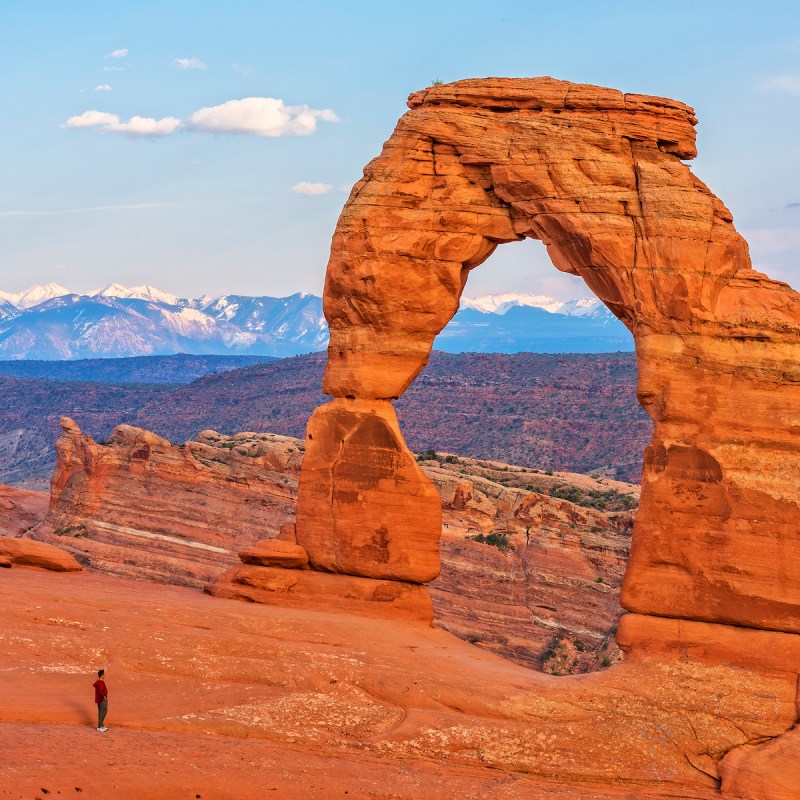
Epic adventures, iconic views, and once-in-a-lifetime experiences — our 15 best hikes in U.S. National Parks are absolutely amazing. Most also require a significant amount of preparation and a few are some of the most dangerous hikes in the U.S. Of course, you can hike as much or as little of the trails below as you’d like. Just know your limits and enjoy.
Videos by TravelAwaits

1. Appalachian National Scenic Trail (Winner)
The Appalachian Trail, or A.T. as it’s known, runs 2,190 miles through 14 states from Spring Mountain, Georgia, to Katahdin, Maine. While only a few hundred hike the entire trail every year, it’s easy for everyone to enjoy portions of this varied and beautiful trail. It runs through Great Smoky Mountains and Shenandoah National Parks; Blue Ridge Parkway, C&O Canal, and Harpers Ferry National Historical Parks; and Delaware Water Gap National Recreation Area. The trail is marked with painted white rectangles on trees and rocks. Cairns are used to mark the trail when it’s above the treeline.

2. Emerald Lake Trail
Rocky Mountain National Park
Located in one of the more popular areas of Rocky Mountain National Park, arrive early if you plan to hike Emerald Lake Trail, or take the shuttle. The trail is 4.1 miles out and back with an elevation gain of 744 feet. Along the way, you’ll pass Nymph and Dream Lakes, which make this trail even more spectacular. Take a few bites to eat and sit and enjoy the view once you make it to Emerald Lake before you begin your return trek.
Rocky Mountain National Park does require a timed entry permit if you want to drive into the park through October 22, 2023.

3. The Narrows
Zion National Park
The Narrows is one of the most popular hikes in Zion National Park, but it requires proper preparation. It’s the narrowest section of Zion Canyon and you will get wet as the trail follows the Virgin River through the gorge. At times, you’ll be in ankle-deep water, while at others, you may need to swim. If you plan to hike all 16 miles, a permit is required. The hike can be completed in 1 or 2 days if you receive an overnight backpacking permit. It’s important to check the weather and flow of the river no matter how much of The Narrows you plan to hike. Here are a few other tips from writer Cindy Barks before you tackle this trek.

4. Delicate Arch Trail
Arches National Park
Delicate Arch is not only the iconic symbol of Arches National Park, it’s become the symbol for the entire state of Utah. This means a hike to Delicate Arch is likely to be crowded. It’s a 3-mile trail out and back with an elevation gain of 480 feet. Almost the entire hike is uphill on sandstone and there’s very little shade. You will need to bring plenty of water, especially if you’re hiking on a hot day. The trail could be icy if you’re visiting during the winter.
Arches National Park does require timed entry reservations during certain hours of the day from April 1 through October 31.
Delicate Arch is very popular at sunset and the parking lot fills quickly throughout the day. I would recommend visiting at sunrise; it’s cooler and less crowded, you can get in without a reservation, and it is a really beautiful experience. Just bring a headlamp or flashlight if you’re starting the hike when it’s still dark.

5. Rim To Rim – South Kaibab Trail & North Kaibab Trail
Grand Canyon National Park
Hiking from the Grand Canyon’s South Rim to its North Rim is an immense undertaking. While there are a few ways to accomplish the feat, our readers chose South Kaibab Trail to North Kaibab Trail, which is about 20 miles total. Bright Angel to North Kaibab is another popular option. Park rangers say to plan for the hike up to take twice as long as the hike down and bring plenty of water. The temperature at the base of the Grand Canyon is usually about 20 degrees warmer than the rim. A stay at Phantom Ranch is a great way to break up the hike, but it’s difficult to get reservations.
Park rangers also offer this important information before hiking any trails in the Grand Canyon.
6. John Muir Trail
Yosemite, Kings Canyon, And Sequoia National Parks
The John Muir Trail is 211 miles long and mostly overlaps the amazing Pacific Crest National Scenic Trail in the Sierra Nevada Mountains. The JMT runs from Yosemite Valley to Mount Whitney — the highest peak in the lower 48. The trail offers amazing views as well as beautiful lakes, meadows, waterfalls, and towering peaks along the way.
Permits are required for anyone wanting to hike the John Muir Trail. The entire Pacific Crest Trail is 2,650 miles long and runs from Mexico to Canada.

7. Angels Landing
Zion National Park
The hike to Angels Landing in Zion National Park is known as one of the most dangerous in the U.S. It’s also become so popular in the last few years that a permit is now required to access it. The total hike is 5.4 miles round-trip with 1,488 feet of elevation gain and takes about 4 hours to complete. Hikers can access the West Rim Trail to Scout Lookout without a permit, but the notorious portion from Scout Lookout to Angels Landing — with sheer drop-offs and a simple chain as your guide — now requires a permit for everyone’s safety.
While loving heights may be the main requirement, writer Cindy Barks shares a few other things you should know before hiking Angels Landing. Even if you don’t make it to the top, the hike offers amazing views of Zion Canyon along the way.
8. Mist Trail
Yosemite National Park
Mist Trail in Yosemite National Park takes hikers from Happy Isles Nature Center along two of the park’s most famous waterfalls, Vernal and Nevada Falls, making it one of the more popular hikes in the park. As the name suggests, the spray from Vernal and Nevada Falls means you’ll likely get wet, even soaked, so pack rain gear, dry socks, and wear quick-drying clothes. Park rangers respond to dozens of knee and ankle injuries along the trail every year from the two sets of stairs and advise that appropriate hiking shoes are a must.
Those who’ve hiked the trail agree the views make the extra effort worth it. The entire trail is about 6.4 miles and takes an average of 4 hours to complete.

9. Empire Bluff Trail
Sleeping Bear Dunes National Lakeshore
Located on the shore of beautiful Lake Michigan, Empire Bluff Trail is a 1.5-mile, out-and-back hike with a major payoff — sweeping views 400 feet above Lake Michigan with Sleeping Bear Dunes just to the north. The hike is mostly shaded with a few interesting finds along the way, like a piece of farm-mowing equipment from the time of the Great Depression.
The entire area is gorgeous and the hike is just a part of a wonderful weekend at Sleeping Bear Dunes in northern Michigan.
10. Half Dome Day Hike
Yosemite National Park
Iconic Half Dome is an awe-inspiring figure in Yosemite National Park. While it can be easily viewed from several areas in the park, hiking to the top comes with significant warnings from park rangers. They describe the hike as extremely challenging and dangerous. It’s 14 miles round-trip with an elevation gain of 5,000 feet, ending with a cable climb to the top. While getting to the top may seem like the toughest part, hiking down the cables can be even more of a challenge.
The entire hike takes 12 hours and park rangers recommend starting before sunrise. A permit is required.

11. Jenny Lake Trail
Grand Teton National Park
The beautiful Jenny Lake Loop Trail travels 7.5 miles around Grand Teton National Park’s Jenny Lake. The hike offers beautiful views of the Tetons, Hidden Falls, gorgeous meadows, and of course, the lake. It’s a popular trail and can be crowded. You can also explore the lake on a beautiful boat ride.
12. Bright Angel Trail, South Rim
Grand Canyon National Park
Bright Angel Trail is known as the most popular trail in Grand Canyon National Park. Easily accessed from the Rim Trail at the western end of Grand Canyon Village, Bright Angel Trail is nearly 7.8 miles to the Colorado River. The trail can be crowded, especially during the first few miles. Park rangers don’t recommend hiking the entire trail as an out-and-back day hike. No matter how much of the trail you want to experience, park rangers say to allow twice as long for the hike up compared to the hike down, bring plenty of water, and prepare for extreme temperature changes.
13. Rim Trail, South Rim
Grand Canyon National Park
This is likely the easiest trail on the list and it offers jaw-dropping views throughout, taking visitors along the beautiful South Rim of the Grand Canyon. Starting at the South Kaibab Trailhead, the trail runs 13 miles to Hermits Rest. This trail is easily accessible from Grand Canyon Village and you can enjoy as much or as little of the trail as you’d like. Spend the night along the South Rim and enjoy portions of the trail when the day visitors leave. Get up early and watch the sunrise, then pick another spot along the way for a perfect sunset.

14. South Rim Trail Loop
Big Bend National Park
The South Rim Trail Loop is a strenuous but amazing 12.7-mile hike in Big Bend National Park. The trail offers breathtaking views of the Chisos Mountains and the Chihuahuan Desert. Along the trail, you’ll also see Emory Peak — the highest in the park. Be sure to keep an eye out for javelinas, mule deer, birds, and a variety of reptiles as well. The loop takes 6–8 hours to complete and includes a 2,800-foot elevation gain.
15. Cadillac North & South Ridge Trails
Acadia National Park
Both Cadillac North Ridge Trail and Cadillac South Ridge Trail take hikers to the same place: the highest point in Acadia National Park on the coast of Maine. Known as the first place to see the sunrise in the U.S. — at least from early October to early March — sunrise is the busiest time to visit Cadillac Mountain.
The South Ridge Trail is longer, 7.1 miles out and back, and offers beautiful views of the islands off Mount Desert Island in the Atlantic. The North Ridge Trail is 4.4 miles out and back and is mostly rocky, offering views of adorable Bar Harbor and beautiful Frenchman Bay.
You can also drive to the summit, but a vehicle reservation is required from the end of May through the end of October.
Be sure to take a look at all of our 2023 Best Of Travel Awards:

